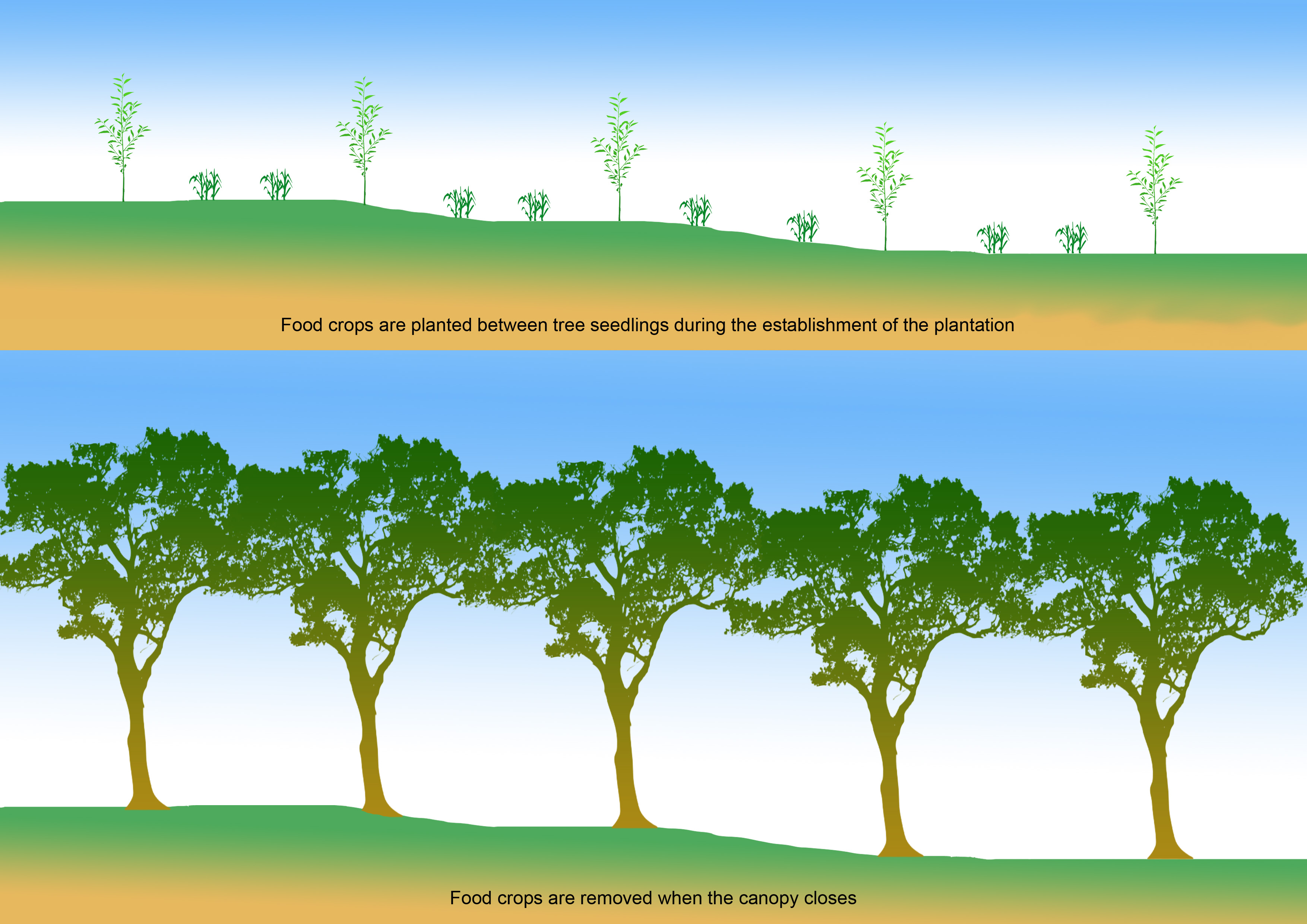Home » History and Development of Agroforestry
Agroforestry: A Land Management System that Increases Both Yield and Resilience of Agriculture
History and Development of Agroforestry
The word “agroforestry” arose in the 1970s but the concept and practices of integrating trees in agricultural systems have been around different parts of the world since ancient times (FAO, 2019a; Steppler & Nair, 1987). Many of the tropical regions have traditions of including trees in their farming systems. Trees play a critical role in simulating the forest structures to mitigate soil erosion, leaching and poor soil nutrients and composition, which are caused by the high precipitation and temperature of the tropical climate.
Taungya is one of the oldest systems of agroforestry that was widespread in South East Asia. It is a system of forest plantation believed to be originating from Myanmar, during the British colonial period in the nineteenth century for the production of Teak (Steppler & Nair, 1987). Research also suggested that a similar system has been used in Southern China for over three hundred years (Menzies, 1988).
Taungya is a forest management system in which food crops are planted at an early stage with timber species seedlings (FAO, 2019a). Plantation of food crops utilise the spaces between and under tree seedlings. The food crops provide income for farmers while awaiting the trees to mature. As the trees grow and the canopy closes, the light level under the shades declines and the plantation becomes solely for timber production. The process is repeated after the timber is harvested.
The Taungya system provides livelihood to farmers while the timber trees mature. This plantation method was widespread in Myanmar and then in South Africa, India, Java and Thailand. The system is also known as one kind of Forest Village Systems.

Agroforestry had been the mainstream practice prior to the “Green Revolution”[1] in the 1950s-60s when input-intensive monoculture became dominant worldwide in an attempt to increase yield.
[1] Green Revolution refers to the spread of high-yielding varieties of crops which require the input of fertilizers and pesticides to achieve the high yield.

Photo courtesy of U.S Department of Agriculture (USDA) : Source: Gene Alexander/USDA
However, the tremendous increase in yield during the “Green Revolution” was not achieved without a price. The social and environmental impacts associated with the changes in the agricultural production model emerged. The rural small-scale farming communities, who lacked technologies and resources to shift to input-intensive monoculture, are excluded from the “Green Revolution”. The small-scale farmers remain poor and underprivileged. The persistence of this situation drew international attention. Agroforestry, which requires fewer technologies and resources, was then recognized as a useful practice to improve the lives of the rural poor. The establishment of the International Council for Research in Agroforestry (ICRAF) in the late 1970s testified the scientific basis for the traditional practices of combining agriculture and forestry. This helps agroforestry to gain popularity as a system that yields multiple outputs and at the same time conserve and rehabilitate the natural environment (Steppler & Nair, 1987).
In the 1990s, the use of agroforestry was recognized as a solution to habitat degradation and reduced biodiversity in areas practising industrialized farming (Montagnini, 2017). For example, National Agroforestry Centre (NAC) was set up under the United States Department of Agriculture (USDA) with the authorization of the Farm Bill in 1990 to promote the adoption of agroforestry through researches (NAC, 2020). NAC identified five agroforestry practices in temperate regions, namely:
- Windbreaks;
- Riparian forest buffers;
- Alley cropping;
- Silvopasture; and
- Forest farming
Conservation Practice Standards have been developed for each practice to guide the establishment and management of the practices. As the research and development advanced in the past decades, agroforestry has been considered a pathway to achieve some of the Millennium Development Goals (MDGs) (Garrity, 2004) and later on Sustainable Development Goals (SDGs) (Montagnini, 2017) proposed by the United Nations (UN) under the climate change scenario.
Agroforestry is now promoted all over the world as one form of sustainable food productions but it is yet to be the mainstream farming practice due to various challenges in its implementation.
References:
FAO. (2019). About agroforestry. Retrieved from Agroforestry: http://www.fao.org/forestry/agroforestry/en/
Garrity, D. P. (2004). Agroforestry and the achievement of the Millennium Development Goals. Agroforestry systems, 5-17.
Menzies, N. (1988). Three Hundred Years of Taungya: A Sustainable System of Forestry in South China. Human Ecology. 16., 361-376.
Montagnini, F. (2017). Integrating Landscapes: Agroforestry for Biodiversity Conservation and Food Sovereignty. Cham: Springer International Publishing.
NAC. (2020). About the Center. Retrieved from National Agroforestry Center U.S. Department of Agriculture: https://www.fs.usda.gov/nac/about/index.php
Steppler, H. A., & Nair, P. R. (1987). Agroforestry: a decade of development. Nairobi: International Council for Research in Agroforestry.
World Agroforestry (ICRAF). (2019). What is Agroforestry? Retrieved from World Agroforestry: http://www.worldagroforestry.org/about/agroforestry
Continue to "Types of Agroforestry"
© 2022 Centre for Civil Society and Governance at The University of Hong Kong
Except where otherwise noted, contents of this e-study is licensed under a Creative Commons Attribution-NonCommercial-ShareAlike 4.0 License.
![]()


